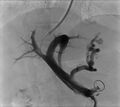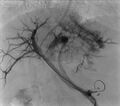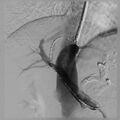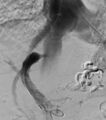TIPS(Transjugular Intrahepatic Portosystemic Shunt)
'TIPS' or transjugular intrahepatic portosystemic shunt is an artificial fistula in the liver parenchyma between the 'branches portal veins' and ' hepatic vein '. This method of "percutaneous portocaval anastomosis" is used to treat portal hypertension because it reduces the overpressure in the portal circulation and thus reduces the flow and blood pressure in the collaterals formed.
Indication[edit | edit source]
Indications for TIPS are acute uncontrollable or recurrent esophageal varices, Budd-Chiari syndrome, refractory ascites, hepatorenal syndrome and planned surgery liver.
Contraindications[edit | edit source]
Contraindications to TIPS are hepatocellular insufficiency, hepatic encephalopathy, hepatic artery stenosis, DIC, extensive hepatocellular carcinoma, cardiac insufficiency or even thrombosis in the bed v. jugularis, v. cava inferior, or cavernous reconstruction of the portal vein.
Execution[edit | edit source]
The operation is preceded by dynamic CT or MR liver, laboratory examination of renal function and detection of possible coagulopathies. A shunt is created between the right or middle hepatic vein 'and the' 'right or left branch of the portal vein' . First, a special cannula is inserted percutaneously via the jugular vein, which is curved at its end and portal puncture, balloon dilatation of the liver parenchyma and stent implantation are performed. In the case of established collaterals filling esophageal varices, their embolization is performed. The most painful part of the operation is dilatation of the intrahepatic tract, when it is necessary to administer analgesics. During exercise, 'pressures in the portal and liver veins are' measured before and after TIPS. The 'port system gradient' value should not exceed 12 mmHg' after TIPS.
Complications[edit | edit source]
During an attempt to puncture the portal vein, the hepatic fascia may be disrupted with hemoperitoneum , usually treated without sequelae. More severe is severe bleeding from the laceration of the extrahepatic part of the portal vein ', which leads to hemorrhagic shock. Hepatic artery or bile duct puncture may also occur.
Clinical complications are caused by a 'sudden change in circulation' ', an increase in central venous pressure, which can lead to pulmonary edema. Acute liver failure sometimes occurs. As many as a quarter of patients develop portosystemic encephalopathy . Patients are given rifaximin or lactulose to prevent encephalopathy. 'Acute short-circuit failure' early thrombosis is usually caused by technical difficulties. 'Chronic insufficiency TIPS' is due to ' intimal and pseudointimal hyperplasia' , which leads to stenosis in as little as 6 months in up to 70% of patients. There is a 'recovery of portal hypertension' , prevented by regular ] ultrasound shunt inspection with the possibility of early diagnosis and dilatation with a balloon catheter.







